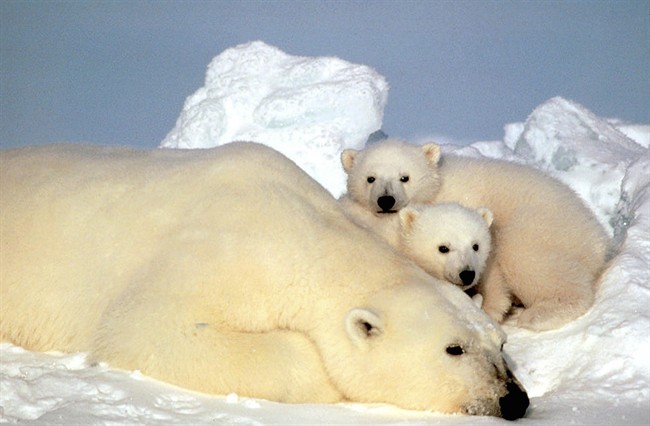ANCHORAGE, Alaska — Polar bears forced off sea ice because of global warming will not find enough food to replace their current diet of fat-laden marine mammals such as seals, researchers say in a paper, a conclusion that contradicts studies indicating they could be embracing bird eggs, berries and other land food sources.

Few bears are using land food and what they find can’t replace lipid-rich ringed or bearded seals, said Karyn Rode, a U.S. Geological Survey research wildlife biologist and lead author of the review paper published Wednesday in the journal, Frontiers in Ecology and the Environment.
READ MORE: Environment Minister retweets dead polar bear photo, angers conservationists
The paper reviews current polar bear research. It’s aimed at recent research documenting bears feeding on land and suggestions that terrestrial foods are becoming more important for them, which could give them hope for survival as summer sea ice recedes and chances to kill seals diminish.
But not everyone agrees with the conclusions reached by Rode and the other authors at Washington State University and Polar Bear International.
Robert Rockwell, a population biologist and ecologist at City College of New York, who is also affiliated with the American Museum of Natural History, has conducted research at western Hudson Bay for 47 years. He has watched polar bears change their behavior to gorge on goose eggs and caribou calves, he said Tuesday.
“I find it hard to believe they’re going to get nothing out of it,” he said.
Polar bears are marine mammals that spend most of their lives on sea ice. They use the frozen ocean to hunt, often catching ringed seals by collapsing their snow lairs as female seals nurse pups.
The world’s 19 polar bear populations are divided into four regions. In three, entire populations historically remained on sea ice year-round. The fourth has seasonal sea ice and includes Hudson Bay, where polar bears have always spent time on land.
PHOTOS: Young polar bear Humphrey arrives in Winnipeg from Toronto
The Bush administration in 2008 listed polar bears as threatened because of an alarming loss of summer sea ice and climate models indicating major declines in polar bear distribution and abundance.
Land food such as berries can be abundant for polar bears but of low quality, Rode said. Eggs from ground nests are higher quality but limited. Polar bears feeding on berries lose significant weight, Rode said.
“There is evidence that some bears are using terrestrial sources in a place such as Hudson Bay, but there’s been no evidence that it’s contributing a significant amount to their energy requirements,” Rode said.
“This paper establishes in no uncertain terms that polar bears are very unlikely to be able to make a living on land, and that if we don’t save the sea ice, polar bears will indeed be gone,” said another author, Steven Amstrup, chief scientist at Polar Bear International and a retired USGS polar bear researcher, in an email statement.
Polar bears on land face competition for food from Arctic foxes, birds and grizzly bears. Rode said. Arctic grizzlies are among the smallest of their species.
“Food limitations would be particularly problematic for the much larger polar bears, which often have a body mass double that of Arctic brown bears,” the authors said.
Studies suggesting polar bears have benefited from food on land have not assessed the food’s energetic contribution, Rode said. The ultimate indicator of any land food benefit would be their health, she said.
“In western Hudson Bay, where more high-quality terrestrial food (birds, bird eggs, and caribou) may be more readily available than in most other Arctic landscapes, survival rates and population size have declined with increasing time spent on land despite terrestrial foraging,” the authors said.
Rockwell said the paper may be using outdated information. The paper cites western Hudson Bay polar bear research from more than a decade ago, before bears started coming ashore early to feed on snow geese and caribou calves.
Rode and her colleagues have underestimated the number of bears eating food on land and discount that polar bears can learn new behavior, he said. One bear he documented raided 250 eider nests in 96 hours and filled 20 percent its annual caloric intake.
“My 47 years of experience tells me these bears are changing their behavior,” he said. “How much is that going to benefit them? I don’t know. It’s got to benefit them some. If you eat the eggs from 40 nests, then you just consumed the same number of calories as if you ate a seal.”



Comments